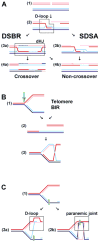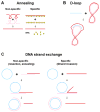Biochemistry of eukaryotic homologous recombination
- PMID: 21552479
- PMCID: PMC3087616
- DOI: 10.1007/978-3-540-71021-9
Biochemistry of eukaryotic homologous recombination
Abstract
The biochemistry of eukaryotic homologous recombination caught fire with the discovery that Rad51 is the eukaryotic homolog of the bacterial RecA and T4 UvsX proteins; and this field is still hot. The core reaction of homologous recombination, homology search and DNA strand invasion, along with the proteins catalyzing it, are conserved throughout evolution in principle. However, the increased complexity of eukaryotic genomes and the diversity of eukaryotic cell biology pose additional challenges to the recombination machinery. It is not surprising that this increase in complexity coincided with the evolution of new recombination proteins and novel support pathways, as well as changes in the properties of those eukaryotic recombination proteins that are evidently conserved in evolution. In humans, defects in homologous recombination lead to increased cancer predisposition, underlining the importance of this pathway for genomic stability and tumor suppression. This review will focus on the mechanisms of homologous recombination in eukaryotes as elucidated by the biochemical analysis of yeast and human proteins.
Figures



Similar articles
-
Comparison of bacteriophage T4 UvsX and human Rad51 filaments suggests that RecA-like polymers may have evolved independently.J Mol Biol. 2001 Oct 5;312(5):999-1009. doi: 10.1006/jmbi.2001.5025. J Mol Biol. 2001. PMID: 11580245
-
The Shu complex is a conserved regulator of homologous recombination.FEMS Yeast Res. 2016 Sep;16(6):fow073. doi: 10.1093/femsyr/fow073. Epub 2016 Sep 1. FEMS Yeast Res. 2016. PMID: 27589940 Free PMC article.
-
The search for the right partner: homologous pairing and DNA strand exchange proteins in eukaryotes.Experientia. 1994 Mar 15;50(3):223-33. doi: 10.1007/BF01924005. Experientia. 1994. PMID: 8143796 Review.
-
Origins and evolution of the recA/RAD51 gene family: evidence for ancient gene duplication and endosymbiotic gene transfer.Proc Natl Acad Sci U S A. 2006 Jul 5;103(27):10328-10333. doi: 10.1073/pnas.0604232103. Epub 2006 Jun 23. Proc Natl Acad Sci U S A. 2006. PMID: 16798872 Free PMC article.
-
Role of the human RAD51 protein in homologous recombination and double-stranded-break repair.Trends Biochem Sci. 1998 Jul;23(7):247-51. doi: 10.1016/s0968-0004(98)01232-8. Trends Biochem Sci. 1998. PMID: 9697414 Review.
Cited by
-
Regulation of recombination and genomic maintenance.Cold Spring Harb Perspect Biol. 2015 Aug 3;7(8):a016501. doi: 10.1101/cshperspect.a016501. Cold Spring Harb Perspect Biol. 2015. PMID: 26238353 Free PMC article. Review.
-
Biochemistry of Meiotic Recombination: Formation, Processing, and Resolution of Recombination Intermediates.Genome Dyn Stab. 2008 Apr 5;3:91. doi: 10.1007/7050_2008_039. Genome Dyn Stab. 2008. PMID: 20098639 Free PMC article.
-
Error-Prone Repair of DNA Double-Strand Breaks.J Cell Physiol. 2016 Jan;231(1):15-24. doi: 10.1002/jcp.25053. J Cell Physiol. 2016. PMID: 26033759 Free PMC article. Review.
-
Genomic variation in natural populations of Drosophila melanogaster.Genetics. 2012 Oct;192(2):533-98. doi: 10.1534/genetics.112.142018. Epub 2012 Jun 5. Genetics. 2012. PMID: 22673804 Free PMC article.
-
Who's who in human recombination: BRCA2 and RAD52.Proc Natl Acad Sci U S A. 2011 Jan 11;108(2):441-2. doi: 10.1073/pnas.1016614108. Epub 2010 Dec 28. Proc Natl Acad Sci U S A. 2011. PMID: 21189297 Free PMC article. No abstract available.
References
-
- Aihara H, Ito Y, Kurumizaka H, Yokoyama S, Shibata T. The N-terminal domain of the human Rad51 protein binds DNA: Structure and a DNA binding surface as revealed by NMR. J Mol Biol. 1999;290:495–504. - PubMed
-
- Alexeev A, Mazin A, Kowalczykowski SC. Rad54 protein possesses chromatin-remodeling activity stimulated by a Rad51-ssDNA nucleoprotein filament. Nature Struct Biol. 2003;10:182–186. - PubMed
Grants and funding
LinkOut - more resources
Full Text Sources
Other Literature Sources
Molecular Biology Databases
Research Materials
